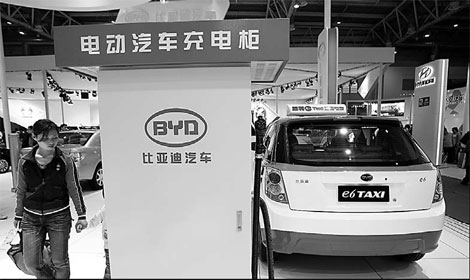News
Green car subsidy trials start in five pilot areas
By Liu Yiyu (China Daily)
Updated: 2010-06-03 07:54
 |
Large Medium Small |
|
A BYD electric car is on display at Auto China 2010 in Beijing. BYD's production goal for its green cars is 1,000 units in 2010. It has no plans to shift to mass production this year. Provided for China Daily |
News of sector incentives pushes lithium-battery maker shares up
Beijing - The government has rolled out the long-awaited incentive program for fuel-efficient vehicles on a trial basis in five cities.
The response from industry observers has been cautiously optimistic due to the small size of the program, which does not encompass Beijing, the city with the greatest vehicle ownership per capita.
The five cities selected for the pilot project are home to major automobile assembly plants including Shanghai, Shenzhen, Hangzhou, Changchun and Hefei.
Effective June 1, buyers will get a 60,000 yuan (8,784) incentive for a wholly-electric car, or 50,000 yuan for a plug-in hybrid car, according to a Ministry of Finance statement.
But the incentives will not go to car buyers but to automakers directly, who will lower the actual purchase price on relevant models accordingly.
Doing so is apparently easier, said Jia Xinguang, an independent consultant in the auto industry, "although there may be problems in transparency and also in the supervision of how the policy is being carried out."
Chinese automaker BYD's spokesman Xu An told China Daily that the incentive program can cover as much as one-third of the price of the company's F3MD, a hybrid passenger vehicle, which sells for between 100,000 yuan and 130,000 yuan.
News of the government's incentive program sent shares of lithium battery makers up in the domestic stock market, with analysts predicting that their revenues would see a rapid rise between 2011 and 2015, when all major domestic automakers are forecast to have first-generation green models on the market.
The five-city pilot project will have a limited impact on carmakers for now. "If the subsidy plan applies only to a few cities, it won't fully boost new-energy vehicle consumption in China," said Kevin Wale, GM China's president and chief executive.
BYD Vice-President Wang Jianjun agreed that the subsidy program would have a limited influence while there are also many other factors affecting the car market. For example, it will take time for consumers to get familiar with green vehicles and businesses will need time to develop related services such as roadside recharging stations, Wale said.
Therefore, BYD's production goal for its green cars is only 1,000 units in 2010 and it has no plans to shift to mass production this year, Wang said.
One remaining problem to affect the spread of green cars is that, even with the subsidy, most green cars will be selling for 200,000 yuan per unit (more than $29,000), and are still more expensive than the gas-powered models, according to Zhao Hang, director of China Automotive Technology Research Center.
Previously, the central government announced it would invest up to 10 billion yuan in the development of new energy vehicles, so that by 2015, there will be between 500,000 to 1 million green cars on Chinese roads.
Auto industry consultant Jia said that, although China is keen on new energy vehicles, especially electric cars, it doesn't mean it's the time for mass sales.
"The fact that new energy vehicles are still in the trial stage is the major reason why the subsidy program is only carried out in five cities," said Zhao, director of China Automotive Technology Research Center.
"To compete with conventional vehicles in the market, companies must speed up technical development and the government needs to increase subsidies," Zhao said.
China Daily
(China Daily 06/03/2010 page16)
